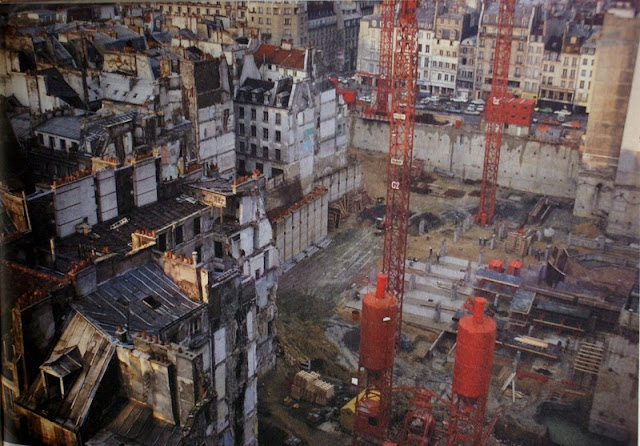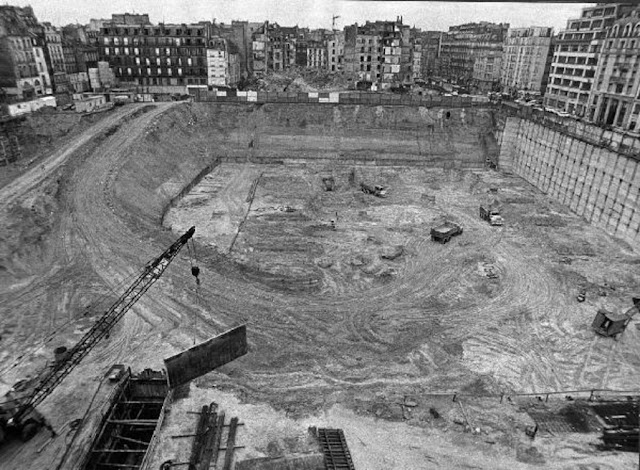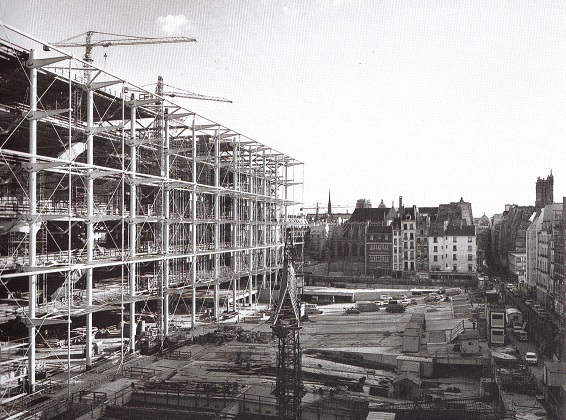
Motivé par sa volonté de modernisation de la société et sa passion pour l’art, le président Pompidou projeta, dès 1969, d’implanter au centre de Paris, un bâtiment novateur dédié à la création contemporaine. L’Etat devait, selon lui, jouer un rôle médiateur en cassant l’image élitiste de la culture désormais accessible au plus grand nombre. Paris devait retrouver une place centrale en la matière et favoriser l’émergence de nouvelles formes d’expressions artistiques. Enfin il s’agissait d’offrir à l’architecture de la seconde moitié du XXe siècle, une représentation digne de ce nom.
président se battit avec acharnement pour poursuivre les travaux.
Driven by his intense desire for social modernisation and his passion for art, President Georges Pompidou announced, in 1969, his plans for the construction of an innovative new building in the centre of Paris entirely dedicated to Modern Art. The state, in his opinion, should play a mediating role in changing the elitist image of art and culture, and make it accessible to as many people as possible. Paris, moreover, could reassert its position as an epicentre of artistic innovation. What’s more, the building would stand as a grand and worthy expositor of architecture in the second half of the 20th century.
The central plateau of Beaubourg was an obvious site, largely occupied by a parking lot, and already earmarked for the construction of a library. In a competition for the winning design, architects Renzo Piano and Richard Rodgers came out on top of 681 entries. Only their proposal met the planning requirements of the urban streetscape. By placing the building’s piping on its exterior, the architects allowed its interior space to be entirely dedicated to exhibition space. Needless to say, the project met with considerable controversy, with some comparing it to an oil refinery. Aside from its exhibition space, the building also maintained an area for the library that had initially been planned. Its main artistic principal revolved around the idea that the visitor would always have access to new exhibitions. Construction began in 1973, despite objections from President Giscard, the successor of Pompidou who died the following year. Jacques Chirac, a close friend of the former president, fought hard to continue work on the building. The museum was finally inaugurated in 1977, in the presence of President Giscard, Prime Minister Raymond Barre and several celebrities.
(traduction – Tim Mc Inerney)
















3 réponses
Marine
génial de voir ça. Merci pour les photos !
Anonymous
Je vais sûrement présenter le centre Beaubourg pour l’histoire des arts et ce document est très interressant. Merci beaucoup.
Anonymous
Merci pour ce reportage, je récupère ainsi un chapitre perdu. Pour une raison que je ne m’explique pas alors que ce chantier était contiguë et contemporain de celui des Halles que j’ai vu a plusieurs reprises, je ne serais pas une seule fois passé à côté!
Merci et félicitations aux concepteurs et aux régisseurs de ce site de première qualité qui est une façon de machine à voyager dans le temps et dans l’espace.
Jérome Ferri